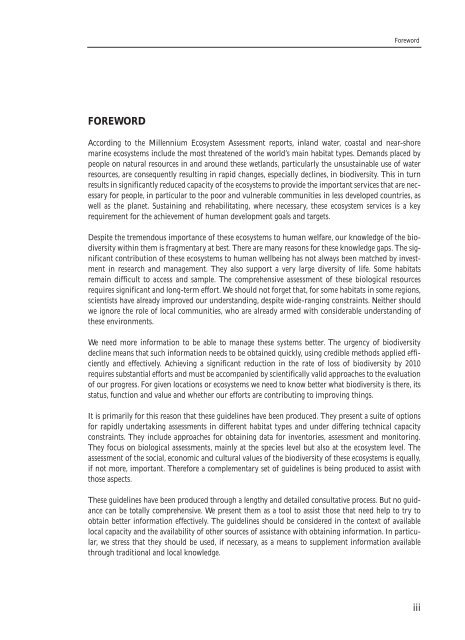Guidelines for the Rapid Ecological Assessment - Convention on ...
Guidelines for the Rapid Ecological Assessment - Convention on ...
Guidelines for the Rapid Ecological Assessment - Convention on ...
Create successful ePaper yourself
Turn your PDF publications into a flip-book with our unique Google optimized e-Paper software.
Foreword<br />
FOREWORD<br />
According to <str<strong>on</strong>g>the</str<strong>on</strong>g> Millennium Ecosystem <str<strong>on</strong>g>Assessment</str<strong>on</strong>g> reports, inland water, coastal and near-shore<br />
marine ecosystems include <str<strong>on</strong>g>the</str<strong>on</strong>g> most threatened of <str<strong>on</strong>g>the</str<strong>on</strong>g> world’s main habitat types. Demands placed by<br />
people <strong>on</strong> natural resources in and around <str<strong>on</strong>g>the</str<strong>on</strong>g>se wetlands, particularly <str<strong>on</strong>g>the</str<strong>on</strong>g> unsustainable use of water<br />
resources, are c<strong>on</strong>sequently resulting in rapid changes, especially declines, in biodiversity. This in turn<br />
results in significantly reduced capacity of <str<strong>on</strong>g>the</str<strong>on</strong>g> ecosystems to provide <str<strong>on</strong>g>the</str<strong>on</strong>g> important services that are necessary<br />
<str<strong>on</strong>g>for</str<strong>on</strong>g> people, in particular to <str<strong>on</strong>g>the</str<strong>on</strong>g> poor and vulnerable communities in less developed countries, as<br />
well as <str<strong>on</strong>g>the</str<strong>on</strong>g> planet. Sustaining and rehabilitating, where necessary, <str<strong>on</strong>g>the</str<strong>on</strong>g>se ecosystem services is a key<br />
requirement <str<strong>on</strong>g>for</str<strong>on</strong>g> <str<strong>on</strong>g>the</str<strong>on</strong>g> achievement of human development goals and targets.<br />
Despite <str<strong>on</strong>g>the</str<strong>on</strong>g> tremendous importance of <str<strong>on</strong>g>the</str<strong>on</strong>g>se ecosystems to human welfare, our knowledge of <str<strong>on</strong>g>the</str<strong>on</strong>g> biodiversity<br />
within <str<strong>on</strong>g>the</str<strong>on</strong>g>m is fragmentary at best. There are many reas<strong>on</strong>s <str<strong>on</strong>g>for</str<strong>on</strong>g> <str<strong>on</strong>g>the</str<strong>on</strong>g>se knowledge gaps. The significant<br />
c<strong>on</strong>tributi<strong>on</strong> of <str<strong>on</strong>g>the</str<strong>on</strong>g>se ecosystems to human wellbeing has not always been matched by investment<br />
in research and management. They also support a very large diversity of life. Some habitats<br />
remain difficult to access and sample. The comprehensive assessment of <str<strong>on</strong>g>the</str<strong>on</strong>g>se biological resources<br />
requires significant and l<strong>on</strong>g-term ef<str<strong>on</strong>g>for</str<strong>on</strong>g>t. We should not <str<strong>on</strong>g>for</str<strong>on</strong>g>get that, <str<strong>on</strong>g>for</str<strong>on</strong>g> some habitats in some regi<strong>on</strong>s,<br />
scientists have already improved our understanding, despite wide-ranging c<strong>on</strong>straints. Nei<str<strong>on</strong>g>the</str<strong>on</strong>g>r should<br />
we ignore <str<strong>on</strong>g>the</str<strong>on</strong>g> role of local communities, who are already armed with c<strong>on</strong>siderable understanding of<br />
<str<strong>on</strong>g>the</str<strong>on</strong>g>se envir<strong>on</strong>ments.<br />
We need more in<str<strong>on</strong>g>for</str<strong>on</strong>g>mati<strong>on</strong> to be able to manage <str<strong>on</strong>g>the</str<strong>on</strong>g>se systems better. The urgency of biodiversity<br />
decline means that such in<str<strong>on</strong>g>for</str<strong>on</strong>g>mati<strong>on</strong> needs to be obtained quickly, using credible methods applied efficiently<br />
and effectively. Achieving a significant reducti<strong>on</strong> in <str<strong>on</strong>g>the</str<strong>on</strong>g> rate of loss of biodiversity by 2010<br />
requires substantial ef<str<strong>on</strong>g>for</str<strong>on</strong>g>ts and must be accompanied by scientifically valid approaches to <str<strong>on</strong>g>the</str<strong>on</strong>g> evaluati<strong>on</strong><br />
of our progress. For given locati<strong>on</strong>s or ecosystems we need to know better what biodiversity is <str<strong>on</strong>g>the</str<strong>on</strong>g>re, its<br />
status, functi<strong>on</strong> and value and whe<str<strong>on</strong>g>the</str<strong>on</strong>g>r our ef<str<strong>on</strong>g>for</str<strong>on</strong>g>ts are c<strong>on</strong>tributing to improving things.<br />
It is primarily <str<strong>on</strong>g>for</str<strong>on</strong>g> this reas<strong>on</strong> that <str<strong>on</strong>g>the</str<strong>on</strong>g>se guidelines have been produced. They present a suite of opti<strong>on</strong>s<br />
<str<strong>on</strong>g>for</str<strong>on</strong>g> rapidly undertaking assessments in different habitat types and under differing technical capacity<br />
c<strong>on</strong>straints. They include approaches <str<strong>on</strong>g>for</str<strong>on</strong>g> obtaining data <str<strong>on</strong>g>for</str<strong>on</strong>g> inventories, assessment and m<strong>on</strong>itoring.<br />
They focus <strong>on</strong> biological assessments, mainly at <str<strong>on</strong>g>the</str<strong>on</strong>g> species level but also at <str<strong>on</strong>g>the</str<strong>on</strong>g> ecosystem level. The<br />
assessment of <str<strong>on</strong>g>the</str<strong>on</strong>g> social, ec<strong>on</strong>omic and cultural values of <str<strong>on</strong>g>the</str<strong>on</strong>g> biodiversity of <str<strong>on</strong>g>the</str<strong>on</strong>g>se ecosystems is equally,<br />
if not more, important. There<str<strong>on</strong>g>for</str<strong>on</strong>g>e a complementary set of guidelines is being produced to assist with<br />
those aspects.<br />
These guidelines have been produced through a lengthy and detailed c<strong>on</strong>sultative process. But no guidance<br />
can be totally comprehensive. We present <str<strong>on</strong>g>the</str<strong>on</strong>g>m as a tool to assist those that need help to try to<br />
obtain better in<str<strong>on</strong>g>for</str<strong>on</strong>g>mati<strong>on</strong> effectively. The guidelines should be c<strong>on</strong>sidered in <str<strong>on</strong>g>the</str<strong>on</strong>g> c<strong>on</strong>text of available<br />
local capacity and <str<strong>on</strong>g>the</str<strong>on</strong>g> availability of o<str<strong>on</strong>g>the</str<strong>on</strong>g>r sources of assistance with obtaining in<str<strong>on</strong>g>for</str<strong>on</strong>g>mati<strong>on</strong>. In particular,<br />
we stress that <str<strong>on</strong>g>the</str<strong>on</strong>g>y should be used, if necessary, as a means to supplement in<str<strong>on</strong>g>for</str<strong>on</strong>g>mati<strong>on</strong> available<br />
through traditi<strong>on</strong>al and local knowledge.<br />
iii

















